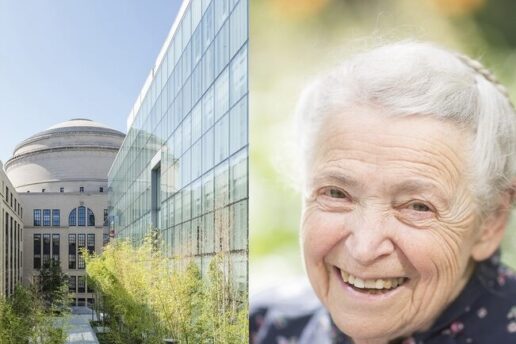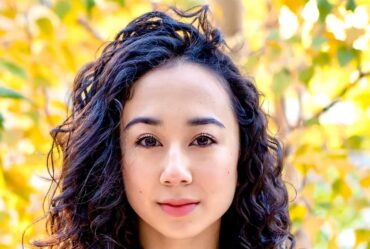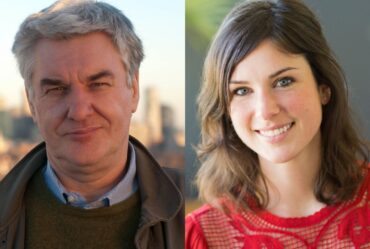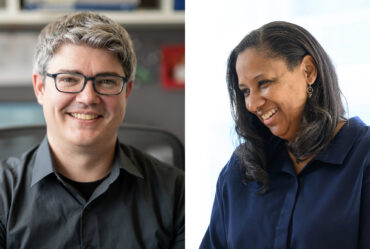
Improbability Walk at MIT.nano honors Mildred Dresselhaus
Courtyard space celebrates beloved professor’s research and mentorship.
The courtyard between the south-facing walls of buildings 4 and 8 and the recently constructed MIT.nano facility has the feel of a meditation space. Overlooked by the great dome, edged with pillars of bamboo, and lined by glass walls on all sides, the walkway has been christened the “Improbability Walk,” in honor of one of MIT’s most inspirational faculty members: the late Institute Professor Mildred “Millie” Dresselhaus.
The name for the space was the idea of Vladimir Bulović, the Fariborz Maseeh (1990) Professor in Emerging Technology. “Millie often used the word ‘improbable’ to describe her success,” recalls Bulović, who is also the founding faculty director of MIT.nano. “And, especially later in her career, she often used the simple act of walking across campus as an opportunity to teach, and to learn from her students. Combining the idea of improbable journeys and walking as a form of mentorship and exchanging ideas seemed a fitting tribute to Millie.”
The roots of walking as an avenue for teaching ran deep for Dresselhaus. While she was studying physics at the University of Chicago in the early 1950s, she lived in the same neighborhood as Nobel laureate Enrico Fermi and walked to campus with him every day, reviewing experiments and talking about their work. Throughout her life, she credited these walks with inspiring her journey to become a professor, researcher, and mentor.
It is no surprise, therefore, that walking and talking became a lifelong practice at MIT with her colleagues and students. “On the way back from seminars, we would always talk about what we’d just learned. Or she would see something — like the Green Building, or a poster about an upcoming lecture — and she would want to tell us about it,” recalls Shengxi Huang PhD ’17 of her many strolls across campus with Dresselhaus. “And she was a really good storyteller.”
Dresselhaus’s appetite for walking and talking, says Xi Ling, a postdoc in Dresselhaus’s lab from 2012 to 2016 and now an assistant professor of chemistry at Boston University, was not limited to the MIT campus, or even just Massachusetts. “We traveled to a lot of conferences, and she was always curious about everything and wanting to tell us stories,” says Ling. “When we went to New Mexico for a conference, she wanted to show us the plants. In Detroit, she wanted to explain to whole city.”
Ling and Huang, however, take issue with Dresselhaus’ description of her path to success as improbable. “To us, seeing her work so hard — attending conferences, writing letters, sitting in the front row at every seminar — it makes perfect sense,” says Ling. “It is very hard for a normal person to do all of these things, and she did it for 60 years!”
But Dresselhaus’s career really was launched in a succession of low-probability events. The child of newly arrived Eastern European immigrants, she grew up in the 1930s in “a dangerous, low-income neighborhood” in the Bronx, she wrote in 2012. But her diligence, her love of math and science, and a series of fortunate coincidences and connections propelled her first to Hunter College, then Radcliffe College, and then the University of Chicago, where she studied physics with Fermi.
When she joined the MIT faculty in 1967, Dresselhaus was one of two women on the science and engineering faculty. Of the approximately 4,000 undergraduates at MIT at that time, roughly 200 were women — and only 28 were studying engineering. As she pursued her research in what would become some of the most important scientific endeavors of the late 20th and early 21st centuries, Dresselhaus also made increasing participation among women in science and engineering a personal responsibility.
With help from her efforts, the landscape shifted. Today, roughly half of MIT undergraduates and more than a third of graduate students are women. And Dresselhaus’s contributions were not limited to the Institute. In 1975, she published “Some Personal Views on Engineering Education for Women” in IEEE Transactions — an open call to her academic colleagues to develop more effective approaches to providing women students with the best training opportunities. She went on to serve as the first chair of the Committee on Women in Science and Engineering for both the National Academy of Science and National Academy of Engineering, inaugurating a range of national programs and activities that continue to this day.
From the perspective of where she began, Dresselhaus’s scientific accomplishments seem just as improbable. In the 1960s, she opted to work in electro-optics of semimetals, such as carbon, because she wanted, in part, “a less competitive research area while we had our babies,” she wrote. Her late-career coronation as the “queen of carbon science” was based on decades of work on the fundamental electronic properties of carbon. Her research gave the world fullerenes, superconductors, and nanotubes — paving the way for whole new avenues of scientific inquiry in nearly every field of physical science and engineering. Working with more than 900 collaborators over the course of her career, Dresselhaus authored more than 1,700 scientific papers and co-wrote eight books.
The catalog of awards and honors earned by Dresselhaus during her career also strains credulity: the Presidential Medal of Freedom, the National Medal of Science, the Kavli Prize, the Enrico Fermi Award, the Vannevar Bush Award, the IEEE Founders medal, 38 honorary degrees, and many, many more. She also led the American Physical Society and the American Association for the Advancement of Science, advised three U.S. presidents, and chaired numerous influential national commissions.
MIT.nano recently hosted the inaugural Mildred S. Dresselhaus Lecture, part of a new series of talks recognizing a significant figure in science and engineering from anywhere in the world whose leadership and impact echo Dresselhaus’s life, accomplishments, and values. The first speaker in the series was Paul McEuen, the John A. Newman Professor of Physical Science at Cornell University and director of the Kavli Institute at Cornell for Nanoscale Science, who presented on Nov. 13 on cell-sized sensors and robots. “When I think of my scientific heroes, it’s a very, very short list, and I think at the top of it would be Millie Dresselhaus,” McEuen said in his opening remarks. “To be able to give this lecture in her honor means the world to me.”
“The Improbability Walk is more than just a place. It’s a call for all of us to invest in the future of MIT, so we can allow people of all backgrounds to succeed — despite the odds,” says Bulović. “It’s also a reminder to all of us that a few simple words, said at just the right moment, can change a person’s life.”


